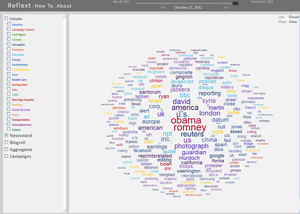Rather than predict the winner of the U.S. presidential election or any local race or issue (yes, Los Angeles is voting on whether porn performers must wear condoms while on the job), I’m going to make the safest bet and suggest that more will be written about the results than anyone sane would care to peruse. But I’ve found a fun online toy from researchers at Cornell that I’ll be deploying to help make sense of the pundit tsunami.
A screen capture of the Reflext interface, with ‘Romney’ and “Obama’ front and center.

It’s called Reflext, and it looks for “associative relationships” between words that appear in prominent news outlets, political blogs, and the presidential candidates’ own blatherings. Rather than get all ontological in explaining the relationship between words that are neither equivalent nor hierarchical or touching on the “latent Dirichlet allocation method for selectional preferences,” let me crib from a press release from Cornell:
What happens if we look at the terms associated with “Romney,” “Obama,” “Euro,” “Medicare,” or other contentious issues? “Medicare” prefers terms such as “cut,” “slash” and “end,” but also appears with “reform,” “expand” and “save,” offering a hint about the perspectives and viewpoints surrounding issues of health care.
To quote Cornell postdoc Eric P. S. Baumer:
“What we’re looking at here is a fundamentally different way of reading. Using tools such as Reflext allows us to see what’s being said between the words and behind them. We can read not only individual articles but also patterns that permeate the broader media ecosystem.”
Using Reflext is definitely a hoot. Starting at cornellhci.org/reflext, the first thing I saw was a word cloud of news terms, their size reflecting how common they’ve been in the past week and their color reflecting which news source has used them the most. The news sources are the Anglo-American usual suspects –BBC World Edition, Fox, NPR, NYT, Reuters, The Atlantic, The Economist, The Guardian, the Wall Street Journal, and an outlier, Al Jazeera English—along with 43 relatively influential blogs on both sides of the U.S. aisle. The interface allows me to select from among the various sources, looking just at the mainstream media, just the blogs, just some of the sources, the candidates’ stump speeches, and even from a palette of issues like foreign policy or the environment. The interface also provides results by full weeks, ranging from May 26, when “Libya’ was a moderately sized word but ‘ambassador’ wasn’t attached to it, to (currently) October 27.
Clicking on a word centers it on the screen and provides a radial tree—think Tesla ball—of the related words, again sorted by size (frequency) and color (source). Clicking then on that related word shows it first in context with the main word, and clicking on that entry gives the entire news story. There’s an attached video tutorial at Reflext, which I recommend.
The beta version has some glitches, but nothing that hurt its underlying utility. Among my quibbles, I couldn’t get it to render the terms in a list format instead of a cloud, for example, and the feature for typing in a term and searching for that wasn’t working for me. And “nbsp” showed up as a news term, instead of being ignored as the HTML code for a non-breaking space.
Obviously, a news story about expanding Medicare coverage wouldn’t require a Ph.D. to decipher the gist. But over time, and across a broader range of perhaps less obviously related terms, the results will—in theory—get more interesting. That’s why I described it as, for me, a toy, and not a tool. Right now I’m figuring out if I’ll learn something substantive or even entertaining by using Reflext, perhaps comparing Fox and Al Jazeera stories on Social Security, say, or will have more fun playing with the box it came in.
Meanwhile, give Reflext a test drive, and let me know your take. I’m betting on tool.




